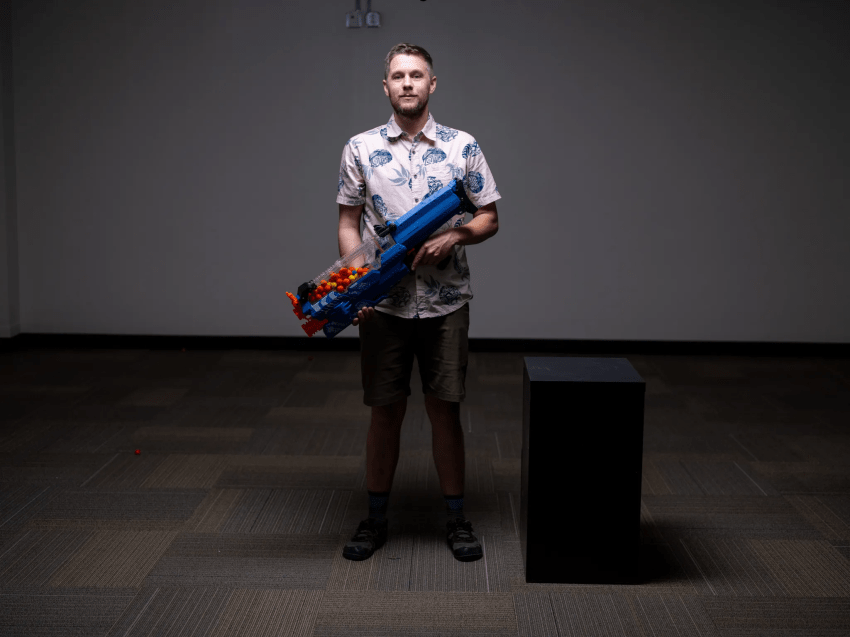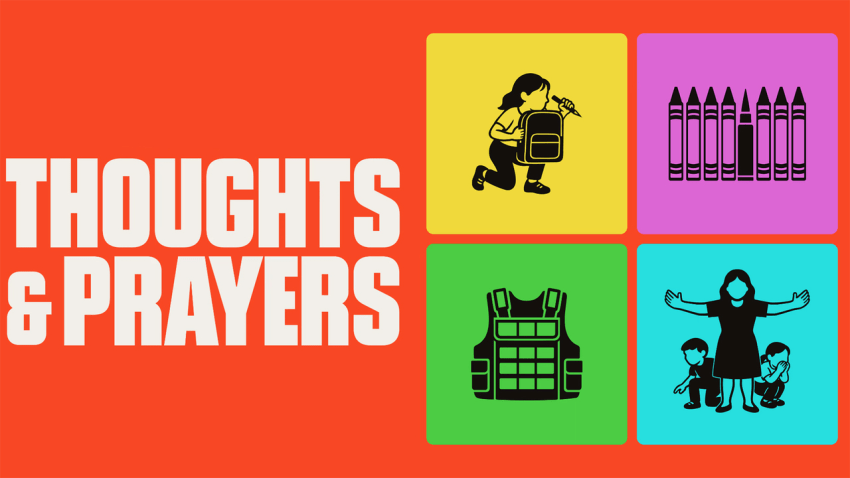
Inside America’s $3 Billion School-Shooting Survival Industry: The Harrowing Reality That’s Exposed In HBO Max’s New Documentary ‘Thoughts & Prayers’
By Erin Whitten
The first few minutes of Thoughts & Prayers: How To Survive an Active Shooter in America make me feel like I’m descending into a collective hallucination.
You watch the camera pan through a marketplace of commodities that appear ridiculous in their first blush. Flip-over bulletproof desks. Toy-sized “barky” robot dogs that howl for help and guard exits when triggered. Inflatable shields for first graders. Bulletproof backpacks. Ballistic window film. Classrooms retrofitted as reinforced shelters. Bulletproof whiteboards. Alarms. Locks. Framed “wall art” designed to stop rifle fire. One vendor sells a skateboard that also serves as a defensive shield. The seller tells us that “every time there’s a tragedy, it economically benefits my family” and predicts that by the time the film airs he’ll be a $300-million company. This is not parody. This is not fiction. It is all real. It all exists because a country has come to accept the idea that children will be murdered at school and that the answer, somehow, is more gear.
The directors, Zackary Canepari and Jessica Dimmock, take a kind of quiet, disquieting neutrality to their material. They frame their subjects formally, their compositions are mostly still. Their interview subjects sometimes gaze directly at the camera, at other times they sit silently, sometimes covered in convincing prosthetic injuries provided by the companies that specialize in latex bullet-hole makeup for use in these drills. The cinematography lingers on faces, on gestures, on the moments of confusion, or resignation, or humor. There is no narrator telling us what to think. We ALL have heard the title of the film – a phrase that Americans now know well as an empty political placeholder carries its own weight of commentary before a single word is spoken.

Thoughts & Prayers documents an entire national apparatus that has been constructed on the idea that nothing meaningful will be done to stop school shootings. Instead, tens of millions of Americans across the country prepare to survive them. More than 20 million adults have received active shooter training. Ninety-five percent of schoolchildren now practice lockdown drills, some as early as pre-K, where the word “gunman” is sanitized with “dinosaur” in a patently half-hearted attempt to make the threat less foreboding. Children rehearse bleeding out, hiding, and escaping in drills so elaborate that they include the participation of the entire school, SWAT teams, realistic gore makeup, and “fake press conferences” staged by students and school administrators at the end of the simulation.
In Utah, we see teachers trained to shoot in six-week programs that also include tactical weapons familiarization, self-defense, emergency medical care, and certification to carry concealed weapons. In that state, teachers are legally allowed to bring firearms into classrooms without even notifying administrators or law enforcement, and the film shows them enrolling in and training inside high-intensity virtual simulations normally used in police academies. We hear one of these teachers speak about how her heart was beating 133 beats per minute inside of the simulator, and then watch her relive the scenario of rounding a corner and taking down a gunman in an instructional space where an instructor reminds her to take deep breaths and only focus on the threat at hand.

In other locations, teachers learn lockdown techniques, how to barricade rooms, how to disarm an active shooter. In Oregon, we watch educators participate in ALICE training, which stands for Alert, Lockdown, Inform, Counter, Evacuate. We also see school districts there conduct drills in which masked “shooters” move room-to-room, barking orders and firing blank rounds in hallways. In New York, we hear a young girl describe school shootings as if they are natural disasters, a choice by the filmmakers that then cuts to footage of hurricanes and mass-casualty events. Across states and school-age groups, the message is the same. Normalization. Children and teenagers talk with heartbreaking lucidity about what they live in fear of: fear of walking into classrooms, fear of losing friends, fear of teachers caring more about their own gun rights than about their students.
The final act of the film is centered on one huge drill at a Medford, Oregon, high school in the wake of the arrest of a janitor who confessed to planning an attack at the school. He had weapons, a written plan, explosives. Students are covered with latex injuries. Police and first responders scour the hallways. A podium is festooned with a sign that reads “fake press conference,” where officials practice the messaging of how many were killed, how many wounded, how they responded, and how they wish it had not happened. All of this is clearly simulated, all of it is clear practice. Then, the drill ends and the superintendent simply flips the sign from red to green, changing “fake press conference” to “real press conference.” He turns to face the screen in the exact same tone, acknowledging the sadness of these exercises, and missing the larger point that they make so plain. They are conditioning us to the idea that tragedy is inescapable.
The filmmakers also capture what is often the ideological escape hatch that gets inserted into conversations around gun violence. We see political bickering flit by on television screens within the film. Senators shouting. Pundits accusing one another of politicizing the issue. All of it is fleetingly captured. They almost never linger on this angle. They do let a trainer named Thrasher make the case that the cause of gun violence is actually family structures and a supposed “lack of tribalism.” It’s an astonishing statement, one the film pointedly cuts away from instead of dismantling with argument. A counterpoint to Thrasher is instead provided by a teenager named Quinn who says the simplest, most heartbreaking thing.
“I don’t think that a lot of adults care about our opinions. We go through this every single day. We go through, like, being afraid of going to school because we might get shot, or we might lose a friend, or we might lose a teacher. And a lot of people care about their … rights, I guess, more about, ‘Oh well, I want to have the ability to own a gun, and so I don’t care if you get shot in your class.’ It’s just kind of disheartening. ‘Cause it’s like, oh, you care more about yourself than all of the students in America.”
Thoughts & Prayers is not a call to action, nor a policy argument, nor an essay on solutions. It is a document of what America has agreed to live with. It shows teachers being trained in combat alongside pedagogy. It shows schoolchildren drilled like emergency responders. It shows companies built to profit from the fear that spikes after each massacre. It shows communities treating mass shootings not as crises to stop but as disasters to endure. It shows a country building a $3-billion survival industry because it refuses to stop the conditions that make that industry necessary.
The result is a portrait of a country that has replaced solutions with simulations, prevention with preparation, and policy with products. A country where drills become traditions, trauma becomes routine, and children themselves become the country’s clearest witnesses to the cost of adult indifference.











